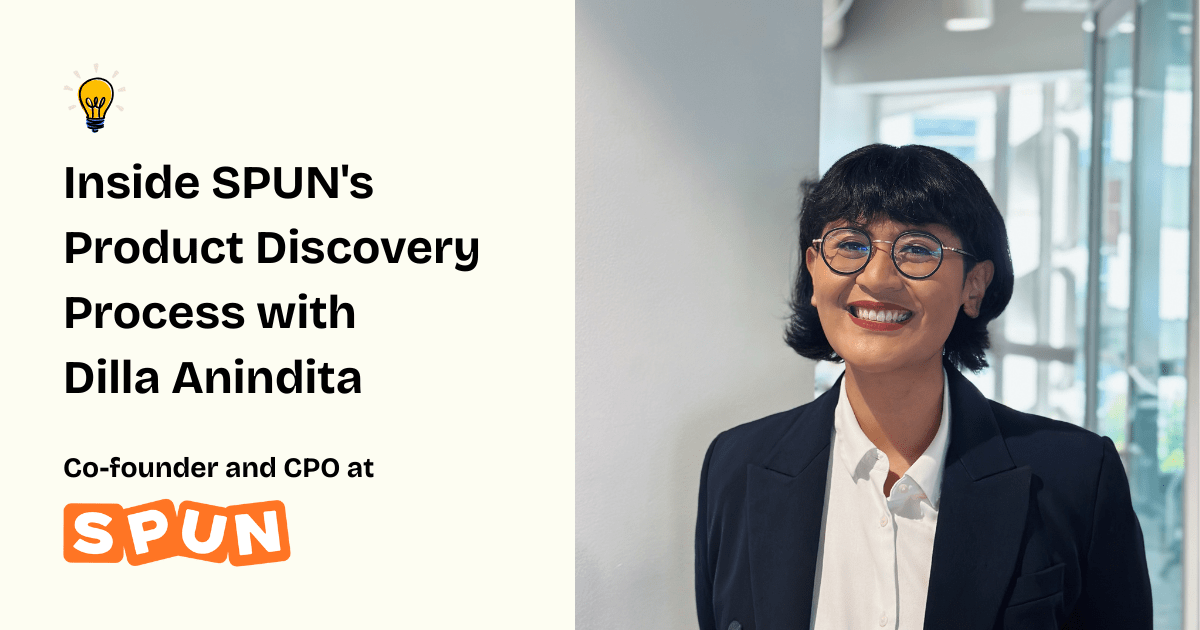As Chief Product Officer and co-founder of SPUN, a modern visa platform, Dilla Anindita is tackling one of the most frustrating aspects of global mobility: navigating visa applications. She’s not just building another tech product, she’s rethinking how we move across borders entirely.
Dilla brings deep product experience from her time at LINE, Grab, and Cookpad, where she led teams across diverse regional markets. In this conversation, she dives deep into the fundamentals of product discovery – from turning messy user interviews into actionable insights, to knowing when you’re on the right track toward product-market fit, and navigating the unique challenges of building products for Southeast Asia’s diverse markets.
Here’s our conversation with Dilla, where they share insights on their journey, challenges, and what’s next:
Let’s start with the basics. What does product discovery look like at your company?
At SPUN, product discovery is a continuous process. We tend to have 2 types of discovery practices: macro & micro discovery (bear with me).
Macro discovery is something we do roughly on a quarterly basis. We take a step back from our everyday work, dedicate 2-3 days with core team members conducting activities like design sprint, ideation, in-depth interviews, or internal workshop to get everyone on the same page and decide priorities & focus areas for the next few months.
Micro discovery is something we do more often—every 1-2 weeks. We split the purpose into two: value testing & usability testing. We usually just talk to users directly to figure these out with some basic hypotheses in mind and try to digest the insights for shorter term decision making (e.g. is this the right thing to build for the next development sprint).
For a founder just starting out, what is the one true goal of product discovery?
Essentially I believe that the goal is to have the conviction that you’re building something people want, one step closer to PMF at a time. Given that, naturally, discovery activities will be more intense in earlier stage founders. The more you do it, you’ll constantly learn something new that may or may not support your existing thesis. These learnings can shift your solution space massively (or not) and that’s OK. Naturally, change is something we should embrace in startups.
How should a busy founder split their time between building and discovery? Is it a phase you complete or a habit you maintain?
In our case, we did product discovery in parallel with our product delivery efforts during our early days—which was indeed exhausting and messy, but was extremely necessary. Once we start to gain conviction on some core directions, discovery works are naturally becoming several cycles ahead of delivery works, although both have their own pipeline. I try to make it a routine still, like a classic dual-track-agile practice, where we set some time-bounds for our efforts (in our case initially weekly cycle, then biweekly after 3-4 months in) and shape up our new goal in the next cycle.
How do you turn messy interview notes into a clear problem statement that your team can actually act on?
My job is to make sure that even before the interview starts, we have a discussion guide prepared with clear hypotheses to test. I believe that most messy interview notes are there because the interviewer isn’t really managing the flow well or hasn’t probed the right questions to begin with. Hence, at SPUN, we made sure that our team knows how to conduct interviews properly to make the most of the time that our users gave to talk to us.
I also try to involve my team in the interview process: have them listen in and gather our thoughts together afterwards. This is the most effective way to get everyone on the same page. If that’s not possible, I make sure that the results are well-mapped in hypotheses —> result table, with extra insights written down below. So people know where to focus.
What’s the most dangerous mistake you see founders make when building a product?
Two things: stuck in landing page + idea stage and building something no one wants.
I’ve seen founders thinking that if they have a landing page done, that’s their product. The reality is this is no longer the early 2010s where getting buy-ins were as easy as that. People need stronger reasons to be convinced why your product is worth their time and usually a landing page is only as good as getting early interests, but never really about testing real values & flows. Seen this a lot in nontechnical founders.
But on the other hand, the complete contrast of that is those who just keep on building without validating what they build. I’ve seen tons of well-coded products with comprehensive end-to-end flows in startup graveyards because it doesn’t solve real problems worth paying for. I’ve seen this a lot in technical founders.
How do you decide what to build when your gut, your users, and your data are all telling you different things?
I usually don’t build unless 2 out of 3 are aligned. I fell into this trap several times throughout my career especially before becoming a founder to “just build” especially when you don’t have the power to control the direction and have to go through the “disagree but commit” mode. But as a founder, you do have the control. This is one of the key reasons why product discovery is so important—getting one step closer to having all 3 stars aligned (qual, quant, gut).
Also fun fact, most times the issue with quant is setting the wrong metrics to track. But that’s a topic for another day 🙂
How do you tell the difference between a user request that’s a real opportunity and one that’s just noise? How do you prioritize what to build next?
First is for founders to sharpen your ICP. And that itself honestly takes several iterations.
For SPUN, we initially started with becoming a platform for digital nomads—helping them navigate with visa matters. Then we feel like this problem doesn’t really click with us for now as their problems are something we don’t resonate with much (we may revisit later tbh) and decided to pivot to ICP closer to our hearts: frequent travelers from Indonesia. With that in mind, we talk to people who know the struggle of constantly making visas everywhere and dealing with rejections and uncertainties—then we realize that this problem is something we can resonate better and have stronger product sense in—so we double down on it.
Second, when we have the right ICP, we try to focus on why they say what they say, not literally what they say (lol sorry). This is what people usually refer to as JTBD. Most times, people have various requests that may or may not make sense, and it’s our job as founders to really digest it into understanding why they “made the request” to begin with.
Prioritization will then come quite naturally. When you do enough discovery iterations, you’ll naturally build your product sense and can eventually prioritize better. Of course there’s always the methodical way to do this more accurately (e.g. crosscheck findings with market size, willingness to pay, and potential future growth).
When you’re searching for product-market fit, what’s a subtle sign that tells you you’re on the right track?
I remember when we still did digital nomad stuff, we wanted to make tools to help them manage their tax matters (before pivoting to visas & permits). So we talked to nomads in Bali about their taxes and they ran away/avoided the topic. But when we ask them about their visa experience, they won’t stop yapping for hours. When we showed them SPUN, they signed up immediately.
Sometimes, PMF comes in forms like that—very random, but when it happens, you know. Also I believe that PMF will evolve as your product stack becomes more complex/serves more than 1 type of customer.
How should discovery change before and after finding product-market fit?
Once you hit PMF, the demand to build things right starts to rise like crazy (beyond building the right things) hence it’s time to sharpen your product delivery practices. The challenge is to make sure that what you ship is good enough not to break but quick enough to ship not to lose the momentum from the market pull. Before PMF, the “pull” won’t be that obvious as you’ll still deal with “does anyone want this?” while after the struggle will be closer to “ok they want this…now let’s ship this well”
What’s your #1 tip for talking to users in a diverse region like Southeast Asia, where communication styles can be very different?
People in SEA tend to give polite answers/go around the point as a way to express dissatisfaction, so you need to adapt your listening skills. Always ask broader questions like “Run me through your previous experience doing X” to understand their behavior/way of expressing things before immediately jumping into questions like “Was your last time doing X hard? Rate it from 1-10”. There are lots of subtexts you need to observe.
But also, each region has its own nuances so there’s no one size fits all approach in interviewing. By listening first, you’ll get the context better and go with the flow accordingly.







